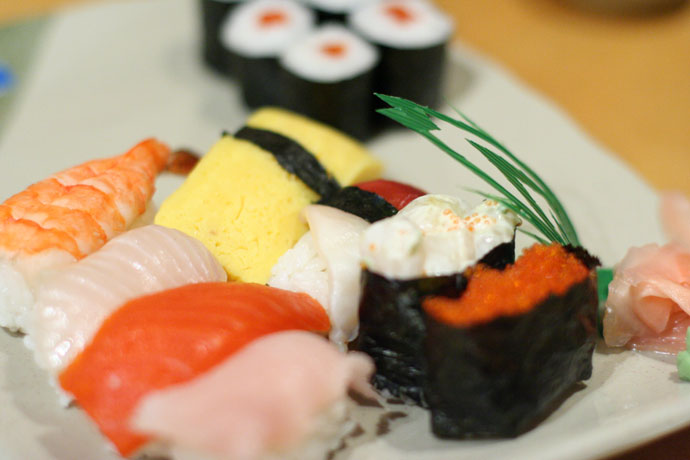I was always skeptical when it came to sushi because of hands constantly touching the rice, fish, and other ingredients that go in the roll. Rice is notorious for harbouring bacteria such as Bacillus cereus, a nasty little germ that is capable of forming a spore and can cause one to seriously embark on a journey of barfing. One of the critical control points in controlling the growth of this bacterium is to acidify the rice, that is, attain a pH of <4.6. Synder1 reports that a pH of less than 4.6 will retard the growth of this bacterium and others such as Clostridium botulinum. I remember when I attempted to make sushi at home, I added enough vinegar to the rice that one bite would have given you an instant gastric ulcer, so I stopped. But are food operators’ testing their product to ensure the rice is at a pH of <4.6?
The Arizona Daily Star reports that Sushi Ten was reported in having 11 critical health violations.
Sushi Ten, a midtown eatery specializing in raw seafood, failed its first health inspection with a new owner, Pima County reported Monday.
The restaurant, which for several years held the top spot for sushi in the Tucson Weekly’s annual "Best of Tucson" survey, amassed 11 critical food-safety violations during an inspection last Wednesday. Critical violations are those that carry the risk of spreading food-borne illness, and an eatery receives a provisional rating if a county sanitarian notices five or more of them.
Sushi Ten, 4500 E. Speedway, will be reinspected within 10 days, said Sharon Browning, manager of the county Consumer Health and Food Safety unit.
Sushi Ten’s owner, David Lam, who took over the restaurant in May, said many of the violations stemmed from his employees not being fully aware of Pima County’s health code. He said he plans to attend a county class to learn more about safe food preparation and to educate his employees.
Most of the violations were corrected during the course of the inspection, Lam said.
The violations included employees failing to wash their hands after handling raw food or dirty dishes, food not being kept at the proper temperature, and potentially hazardous food not being properly date-marked.
Source:
1. Synder, O.P. (2000A). Sushi rice HACCP. Hospitality Institute of Technology and Management.
.jpg)



 In certain regions of Japan, many consider dolphin meat to be a delicacy, though unaware of the dangers associated with the meal. Two elected officials of a Japanese whaling town, Taiji,
In certain regions of Japan, many consider dolphin meat to be a delicacy, though unaware of the dangers associated with the meal. Two elected officials of a Japanese whaling town, Taiji,  Both the short term and long term damages caused by the
Both the short term and long term damages caused by the .jpg) Mital Pandya is a current USDA research scientist in Orient Point, NY. In 2007 she received her Masters degree in Public Health from Ohio State University. She is passionate about food, loves to knit, and travel.
Mital Pandya is a current USDA research scientist in Orient Point, NY. In 2007 she received her Masters degree in Public Health from Ohio State University. She is passionate about food, loves to knit, and travel. Jack Black
Jack Black Hundreds of Inuit at a community festival gathered Monday as Jean knelt above a pair of seal carcasses and used a traditional ulu blade to slice the meat off the skin. After cutting through the flesh, Jean turned to the woman beside her and asked: "Could I try the heart?"
Hundreds of Inuit at a community festival gathered Monday as Jean knelt above a pair of seal carcasses and used a traditional ulu blade to slice the meat off the skin. After cutting through the flesh, Jean turned to the woman beside her and asked: "Could I try the heart?" If you ate at Sushi Haru on October 9, you may still benefit from receiving a vaccination to prevent Hepatitis A infection. The vaccine is effective for up to 14 days after coming into contact with the virus. Today is the last day that the vaccine would be effective. Call your doctor to get the vaccine, or go to a walk-in clinic.
If you ate at Sushi Haru on October 9, you may still benefit from receiving a vaccination to prevent Hepatitis A infection. The vaccine is effective for up to 14 days after coming into contact with the virus. Today is the last day that the vaccine would be effective. Call your doctor to get the vaccine, or go to a walk-in clinic. Inspectors who toured the premises found rat faeces scattered over the floor, on equipment and in food-processing areas. Two 12.5-kilogram bags of flour had been "gnawed open by rodents" and one of the creatures was seen in the food storage area, the court heard.
Inspectors who toured the premises found rat faeces scattered over the floor, on equipment and in food-processing areas. Two 12.5-kilogram bags of flour had been "gnawed open by rodents" and one of the creatures was seen in the food storage area, the court heard.